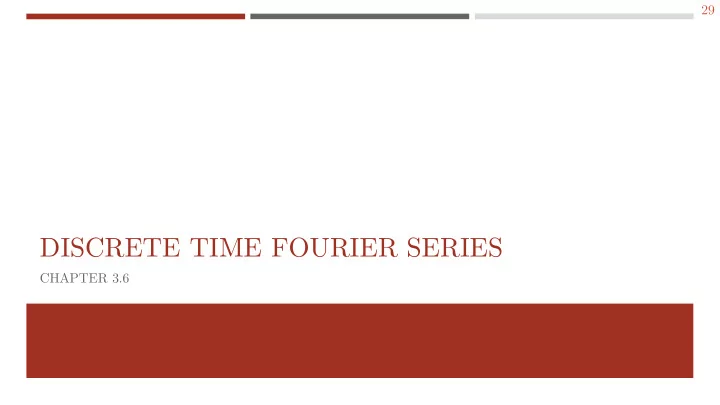

29 DISCRETE TIME FOURIER SERIES CHAPTER 3.6
30 DTFS VS CTFS DIFFERENCES While quite similar to the CT case, DTFS is a finite series, 𝑏 𝑙 , k < K Does not have convergence issues Good News: motivation and intuition from CT applies for DT case
31 DTFS TRANSFORM PAIR Consider the discrete time periodic signal 𝑦 𝑜 = 𝑦 𝑜 + 𝑂 𝑦 𝑜 = σ 𝑙=<𝑂> 𝑏 𝑙 𝑓 𝑘𝑙𝜕 0 𝑜 synthesis equation 1 𝑂 σ 𝑜=<𝑂> 𝑦 𝑜 𝑓 −𝑘𝑙𝜕 0 𝑜 analysis equation 𝑏 𝑙 = 𝑂 – fundamental period (smallest value such that periodicity constraint holds) 𝜕 0 = 2𝜌/𝑂 – fundamental frequency indicates summation over a period ( 𝑂 samples) σ 𝑜=<𝑂>
32 DTFS REMARKS DTFS representation is a finite sum, so there is always pointwise convergence FS coefficients are periodic with period N
33 DTFS PROOF Proof for the DTFS pair is similar to the CT case Relies on orthogonality of harmonically related DT period complex exponentials Will not show in class
34 HOW TO FIND DTFS REPRESENTATION Like CTFS, will use important examples to demonstrate common techniques Sinusoidal signals – Euler’s relationship Direct FS summation evaluation – periodic rectangular wave and impulse train FS properties table and transform pairs
35 SINUSOIDAL SIGNAL 1 2𝜌 4𝜌 𝑦[𝑜] = 1 + 2 cos 𝑜 + sin 𝑜 𝑂 𝑂 First find the period Rewrite 𝑦[𝑜] using Euler’s and read off 𝑏 𝑙 coefficients by 1 1 ∗ 𝑏 0 = 1, 𝑏 ±1 = 4 , 𝑏 2 = 𝑏 −2 = inspection 2𝑘 Shortcut here
36 SINUSOIDAL COMPARISON 𝑦(𝑢) = cos 𝜕 0 𝑢 𝑦 𝑜 = cos 𝜕 0 𝑜 𝑏 𝑙 = ቊ1/2 𝑙 = ±1 𝑏 𝑙 = ቊ1/2 𝑙 = ±1 0 𝑓𝑚𝑡𝑓 0 𝑓𝑚𝑡𝑓 Over a single period must specify period with period N
37 PERIODIC RECTANGLE WAVE Type equation here.
38 RECTANGLE WAVE COEFFICIENTS Consider different “duty cycle” for the rectangle wave 50% (square wave) 25% 12.5% Note all plots are still a sinc shaped, but periodic Difference is how the sync is sampled Longer in time (larger N) smaller spacing in frequency more samples between zero crossings
39 PERIODIC IMPULSE TRAIN ∞ 𝑦[𝑜] = σ 𝑙=−∞ 𝜀[𝑜 − 𝑙𝑂] Using FS integral Notice only one impulse in the interval
Recommend
More recommend